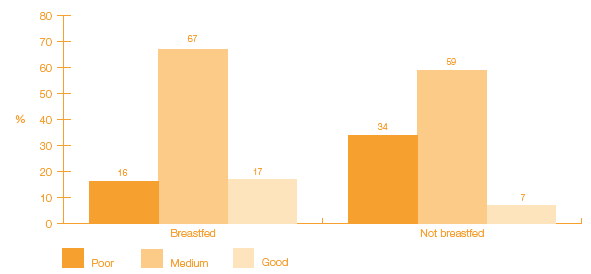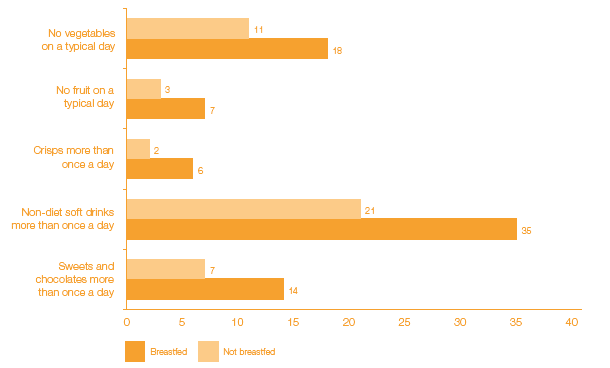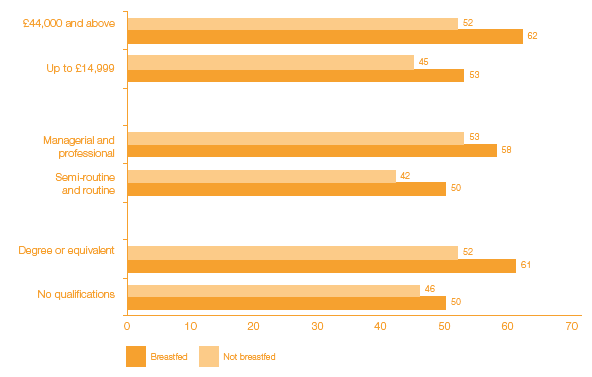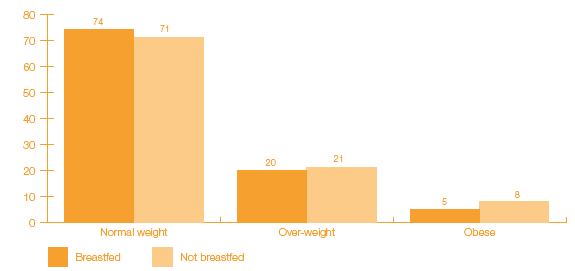Growing Up in Scotland: Sweep 3 Food and Activity Report
This report uses data from the Growing Up in Scotland study to explore the prevalence of, and many issues related to, food and activity in Scotland specifically in relation to young children.
Chapter 5
Breastfeeding and Nutrition in Childhood
5.1 Breastfeeding and nutrition in childhood
Nutritional habits adopted in the early years of life often persist into adulthood. A number of studies have shown that breastfeeding is associated to weight in childhood (Fewtrell, 2004; Gilman et al., 2001; Koletzko, 2004). Apart from having positive effects on weight, there is also evidence that breastfed babies are less likely to develop a range of different infections (Howie et al., 1990; Wilson et al., 1998) and also less likely to develop insulin dependent diabetes in childhood (Sadauskaite-Kuenhne et al., 2004).
Figure 5 A Child's diet type by breastfeeding history

Base: All child cohort: weighted - 2332, unweighted - 2280.
Figure 5 A tells a similar story by comparing how breastfed and non-breastfed children differ on the diet scale. Most children had an average diet. However, 17% of breastfed children had a good diet compared to 7% of those not breastfed, and 16% had a poor diet compared to 34% of those not breastfed. Again, non-breastfed children seem to have relatively inferior nutritional patterns in childhood than their breastfed counterparts.
Figure 5 B Consumption of selected foods by breastfeeding history

Base: All child cohort: weighted - 2332, unweighted - 2280.
Figure 5 B is a good illustration of the different proportions of breastfed compared to non-breastfed children who have unhealthy nutritional habits. For example, non-breastfed children were more likely to drink soft-drinks, and more likely to eat sweets and chocolates more than once a day than were breastfed children. Additionally, the proportion of breastfed children who had no vegetables on a typical day was 11% compared to 18% for those who had not been breastfed. Similar patterns could be seen in relation to healthy and unhealthy snacks.
The association between diet in childhood and breastfeeding history is clear. However, this does not explain if being breastfed is the sole cause of differences in diet or if there are other characteristics which make a mother both more likely to breastfeed and more likely to feed her child healthier foods. Section 2.3.1 showed how children of more educated mothers in managerial and professional occupations and children in better paid households are more likely to have a better diet. In turn, Figure 5 C indicates how the incidence of breastfeeding varies by these same characteristics of the mother and household. It is interesting to note that differences between breastfed and non-breastfed children persist, even when isolated by NS-SEC or income group.
Figure 5 C How many children eat two or three types of vegetables on a typical day by selected characteristics

Base: All child cohort: weighted - 2332, unweighted - 2280.
5.2 Breastfeeding and BMI
Research has shown that children who are breastfed have a lower risk of obesity than those who have not been breastfed. Furthermore, the duration of breastfeeding also makes a significant difference on the risk a child had of becoming obese in later life, with longer breastfeeding lowering the risk (Owen et al., 2005, Toschke et al., 2007).
Figure 5 D shows how breastfed children compare to non-breastfed children in terms of BMI. There appears to be a very slight difference in proportions for those who are obese, with those who were not breastfed being 3% more likely to be obese than those who were breastfed. Although the results do not show a large difference in proportions, perhaps a follow-up study on this cohort at a later age would show if the differences in BMI become more marked as the children grow older (the results from the study by Toschke et al., (2007), for example, looked at the impact of breastfeeding on children aged 9 to 10 years old).
Figure 5 D BMI by breastfeeding history

Base: All child cohort with valid height and weight measurements: weighted - 1979, unweighted - 1987.
Regression analysis was undertaken to test if the relationship observed in Figure 5 D is statistically significant, 8 that is, to test if a child's breastfeeding history can predict their BMI in the following years. The results (see Appendix C for detail) suggest that breastfeeding does have a significant effect on BMI in later childhood, but this effect is minimal, and there are other factors which influence a child's BMI to a much larger extent. However, it should be noted that results may have been different if we could test the effect of breastfeeding duration, that is, the effect of having been breastfed for a shorter or a longer period of time on a child's BMI. While this analysis is not possible with the data available in GUS for the older cohort of children, it will be possible with the younger cohort after the 4th sweep of data has been collected.
Further regression analysis tested the extent to which breastfeeding in infancy predicts a child's diet in later childhood by using the diet score constructed and explained earlier in the report. 9 The analysis suggests that the relationship is statistically significant. Thus, by knowing whether children were breastfed or not, we can explain c.6% of the differences in children's diets as measured by the diet score.
Figure 5 C showed that some differences in breastfeeding patterns could be explained by different socio-economic effects, whilst section 2 showed that the type of diet a child has is also related to these same socio-economic factors. Thus a further model aimed to test if there was an independent significant relationship between breastfeeding and the diet score which could not be explained by other characteristics of the mother and the household. 10 The results showed that breastfeeding significantly predicted diet score, and this effect was not caused by the other factors in the model. On the whole, breastfeeding and the additional four characteristics in the model explained c.15% of the variation in children's diet score.
The results indicate that increased policy emphasis behind promoting breastfeeding is justified, as breastfeeding seems to have an independent positive effect on children's diets, thus raising children's chances for better health outcomes in later life.
There is a problem
Thanks for your feedback